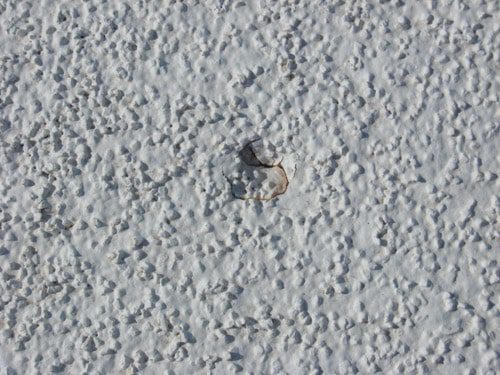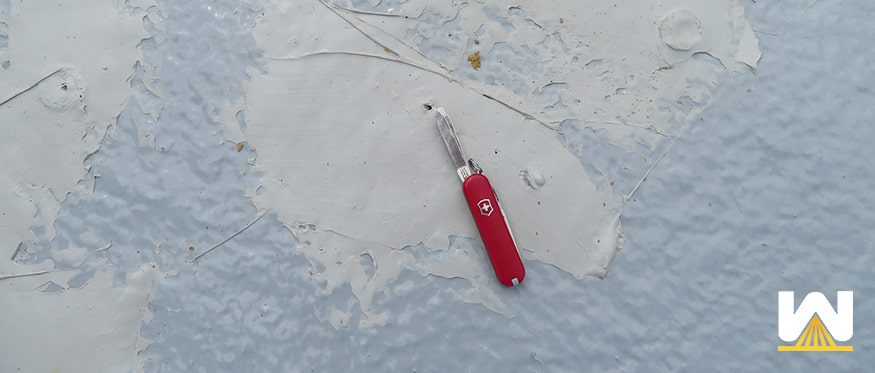Here’s a strong statement to start this off.
Every single roofing system, metal, single-ply, built-up, spray foam, etc., they will all get holes and punctures.
But as a building owner, why should you care?
It would be nice to know the answers to a few questions, such as:
- How does a hole on a spray foam roof happen?
- Will this hole cause a leak in my spray foam roof?
- How does the hole get repaired?
- Is the hole covered under warranty?
And more and more.
In this article, we answer all the questions above, and more when it comes to spray foam roofs, holes, and punctures.
But why would you trust West Roofing Systems?
West Roofing Systems has been installing spray foam roofs since 1979. We also have a full-time service department that fixes holes and punctures on spray foam roofs every single day.
We know how holes happen, what happens if you ignore them, and how soon you need to have them fixed so that you don’t cause permanent damage to your spray foam roof.
Let’s get started!
How does a hole in a spray foam roof happen?
Did you know that while spray foam sounds “weak”, it is far from it?
The foam used for roofing has a compression strength of 50-60 Pounds per Square Inch (PSI). This is similar to the strength the pegs your refrigerator sits on.
A more likely scenario to cause a hole or crack is the sharpness of an object.
Examples of objects that cause holes in spray foam roofs are:
- sharp branches
- nails
- dropped tools
- HVAC panels that can be jabbed into the roof by a contractor (yes, this happens)
What does a hole or crack do to a spray foam roof?

If you’re a building owner, you’re probably wondering if a spray foam roof gets a crack or hole, will it cause a leak?
The answer is no…if it’s repaired on time. On-time usually means the hole is fixed within 6 months. After 6 months, the water that will be inside the hole can start to degrade the foam. Also, the sun will begin to degrade the exposed foam.
Most building owners avoid this issue by signing up for a maintenance contract with a spray foam roofing contractor.
Enrolling in a routine maintenance program ensures that a spray foam roofing expert is on your roof twice per year.
During maintenance, they can identify all cracks, punctures, holes, etc., and fix them before they turn into major problems.
Why doesn’t a hole in a spray foam roof cause a leak?
Spray polyurethane foam is closed-cell. Closed-cell means that if a hole occurs, the water will sit inside that hole and not go anywhere else.
This is different from traditional roofing systems that use polyiso board or other types of insulation, which, when water enters, the water can run horizontally and spread throughout the insulation.
The water keeps entering the same entry point, and further saturates the insulation until it has a chance to enter your deck…and eventually enter your building, causing a leak.
How is a hole, crack, or puncture repaired on a spray foam roof?
Once a hole is identified, the first step is to cut around the area with a pocketknife.
Then a towel and a heating element will be used to get the area dry.
Then you fill the entire area with caulk or silicone coating.
Smooth the area out with a putty knife and you’re done!
How long can you leave a hole on a spray foam roof exposed?
It’s best to fix the hole as soon as possible. But say a storm came through and you didn’t notice that a branch made a small hole.
This hole will not cause a leak in your building for around 6 months. If you have routine maintenance on your roof, then this will not be an issue.
On a single-ply roof, once the seams are open (even a tiny bit), water will enter the insulation and begin spreading horizontally. This will start to cause a leak once the water saturates the insulation and enters the roof deck.
There’s no exact time on when a leak will occur after a hole is made in a single-ply roof, but it will be a lot sooner than a spray foam roof.
NOTE: We encourage our customers to call us after a large storm has happened near their building. We will get on the roof and make sure there was no significant damage.
What happens if you never fix a hole on a spray foam roof?
If you never fix a hole on a spray foam roof, your roof will not last as long as it’s intended to.
The water will eventually break down the foam (even though it’s closed-cell).
The damaged area will spread, be more exposed to sunlight, and eventually, you will have spray foam that degrades down to the deck.
This may take a few years, but I’m sure you weren’t planning on having a commercial roof that only lasted a few years.
If a spray foam roof is properly maintained, it will be the last roof you’ll ever have to install.
NOTE: There are roofs we’ve done in the early 1980s that still have the initial application of spray foam on them. Sure, the coating wears away after 10-20 years, but once you do a recoat, the roof is back under warranty for another 10-20 years. The process keeps repeating. This is how a spray foam roof is a renewable roof system.
Is a hole repair on a spray foam roof covered under warranty?
If a hole is caused by one of the below, it will not be covered under warranty:
- Acts of God – Acts of god would include hail, tornados, and hurricanes.
- Animals – No roofing contractor or spray foam manufacturer will cover damage caused by animals. Bird pecking has been an issue for some spray foam roofs, as well as squirrels and raccoons for any kind of roofing system.
- Other Contractors – There have been plenty of scenarios where another contractor goes onto the roof, causes damage, and the building owner is left wondering who’s going to fix their leak. An example that happens often is an HVAC contractor will go on the roof to service the AC units. They remove the panels and they stick them into the spray foam roof. They can also drop a few nails and screws, step on them, and cause a puncture in the spray foam roof. These types of incidents would not be covered under any warranty type.
The best protection a building owner can have is to have a maintenance program with a certified, SPFA-approved spray foam roofing contractor.
They will be on your roof twice per year and will repair any hole, crack, or puncture before it causes major damage.
Recap of spray foam holes, punctures, and cracks
Hopefully, we’ve relieved the fear that spray foam is a weak system. And hopefully, we relieved the fear that if your spray foam roof does get a hole, crack, or puncture, that as long as it’s fixed in a reasonable time, your roof will last the entire warranty period.
And lastly, if you ignore your roof, it will not last as long as it could. It’s very similar to your vehicle if you don’t rotate/change tires, change the oil, etc. The car will never last as long if you ignore it, as opposed to doing routine maintenance.
West Roofing Systems has been fixing holes and cracks in spray foam roofs since 1979. There’s a reason we have a full-time service department with roofers dedicated to keeping spray foam roofs going.
It’s just that important.
And every building owner will reap the benefits when they don’t have any roof leaks and don’t have any renters complaining about leaks.
What are your next steps?
If you’d like to learn more about spray foam roofing, please take a look at our Ultimate Guide to Spray Foam Roofing (you don’t have to give us any information to view it). This guide answers common questions, such as:
- What kind of energy savings can a spray foam roof provide?
- What happens after the initial warranty period is over?
- How much does a spray foam roof cost on the initial application?


